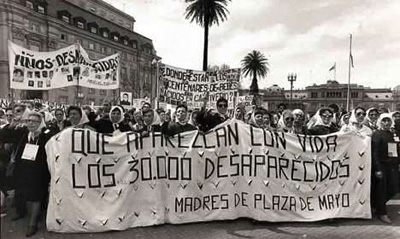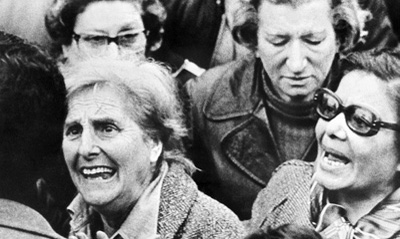Source: See Buenos Aires Index.
Image: Borges speaking about the Madres de la Plaza de Mayo, in his apartment in Summer 1985.
Part 3 of 4
Narrative continued:
To understand what Borges said in his conversation with the Professor-Photographer, we have to look at the historical context in Argentina from 1970 to 1985, when the conversation took place. Following a pattern seen in many Latin American countries in the latter third of the 20th century, many young and progressive Latin Americans of all social classes engaged in activist protests against the authoritarian governments that ruled their countries. In most cases, these activists were following the example of the Cuban Revolution as led by, principally, Fidel Castro and the Argentinian Ernesto (Che) Guevara, who succeeded in overthrowing the dictatorship of Fulgencio Batista in Cuba in 1959. In Argentina in 1970 a group of radicalized followers of the famous presidential dictator, Juan Domingo Perón (1895-1974) began a campaign of often violent revolutionary action against the government. These activists called themselves the Movimiento Peronista Montonero (Montoneros). In 1973 (see 1973 in Chile), the Peronista political party (Frente Justicialista de Liberación) won the national elections, and Perón became president until his death the following year. He was succeeded by his second wife (who was his first wife?), María Estela Martínez de Perón (aka Isabelita), who, from 1974 to 1976, was the first woman head of state in the Western Hemisphere. She was ousted by a military coup (golpe de estado). Meanwhile, Borges, who was completely blind, continued writing prolifically, publishing, and travelling the world as the great Latin American intellectual that he was known to be. Purporting to be supporters of what they called the authentic vision of Peronist social revolution, they began guerrilla warfare against the government. The Montoneros and their para-military wing, the Ejército Revolucionario del Pueblo (People's Revolutionary Army; ERP) attack businesses, politicians, and the military. They killed executives of American interests such as General Motors, Ford Motor Company, and Chrysler; they managed to sink an Argentinian destroyer; and they bombed the Federal Police building in Buenos Aires, killing dozens of people.
The national military reacted ruthlessly by creating paramilitary forces who intimidated, kidnapped, tortured, and murdered over ten thousand (mostly young) Argentine men and women. (This number is most likely at least five times greater than the actual number of Montoneros.) In 1976, Isabel Perón was overthrown by a military coup led by General Jorge Rafael Videla. The military Junta then increased the counter-revolutionary campaign, thus beginning the horrible event known as La Guerra Sucia (Dirty War). During this period (roughly 1976-1981), perhaps as many as 100,000 mostly innocent Argentinians disappeared (los desaparecidos). Among the atrocities committed by the military and paramilitary goons were flying captives out to sea in helicopters and pushing the living victims to their deaths. Other bodies were simply dumped in the streets. Most, however, were simply "disappeared." In 1981, Gen. Roberto Eduardo Viola replaced Videla, and a year later Major General Reynaldo Bignone replaced Viola at the head of the military Junta. Meanwhile, Borges continued to write and publish, but he also maintained his silence. Many intellectuals throughout Latin America and the world felt that Borges was a supporter of the military dictatorships in Argentina and elsewhere.
In 1982 Argentina seized the Islas Malvinas (Falkland Islands), thereby starting a war against Great Britain. (Both countries had claimed sovereignty over these south Atlantic islands off the coast of Argentina since 1833, but Great Britain had held and settled them. At the time of the Argentinian invasion no Argentine residents lived on the islands.) A month later, a great armada of the British Navy landed on the islands and within six weeks the British had defeated the Argentine forces. This Argentinian military defeat effectively brought down the dictatorship. In 1983, then, the famous women known as the Madres de la Plaza de Mayo began massive demonstrations on behalf of their disappeared children (los desaparecidos. On October 30th, democratic elections we held and Raúl Alfonsín of the Radical Civic Union Party) was elected president.
Here ends the third, and historical, segment this real-life story.
The last segment narrates the serious meat of the story—and it is very serious indeed.
| For Part 4, click on this image: => |
 |



